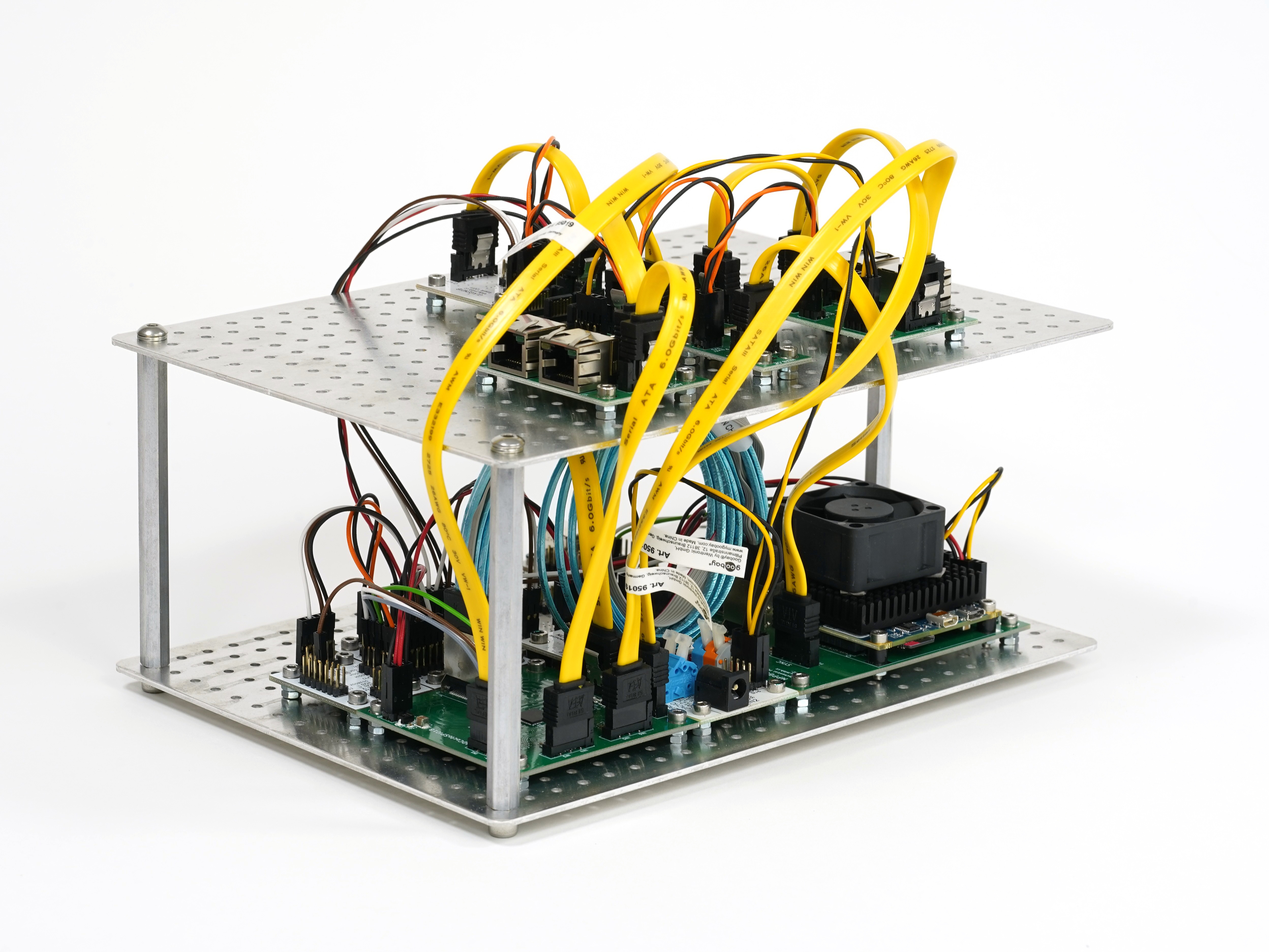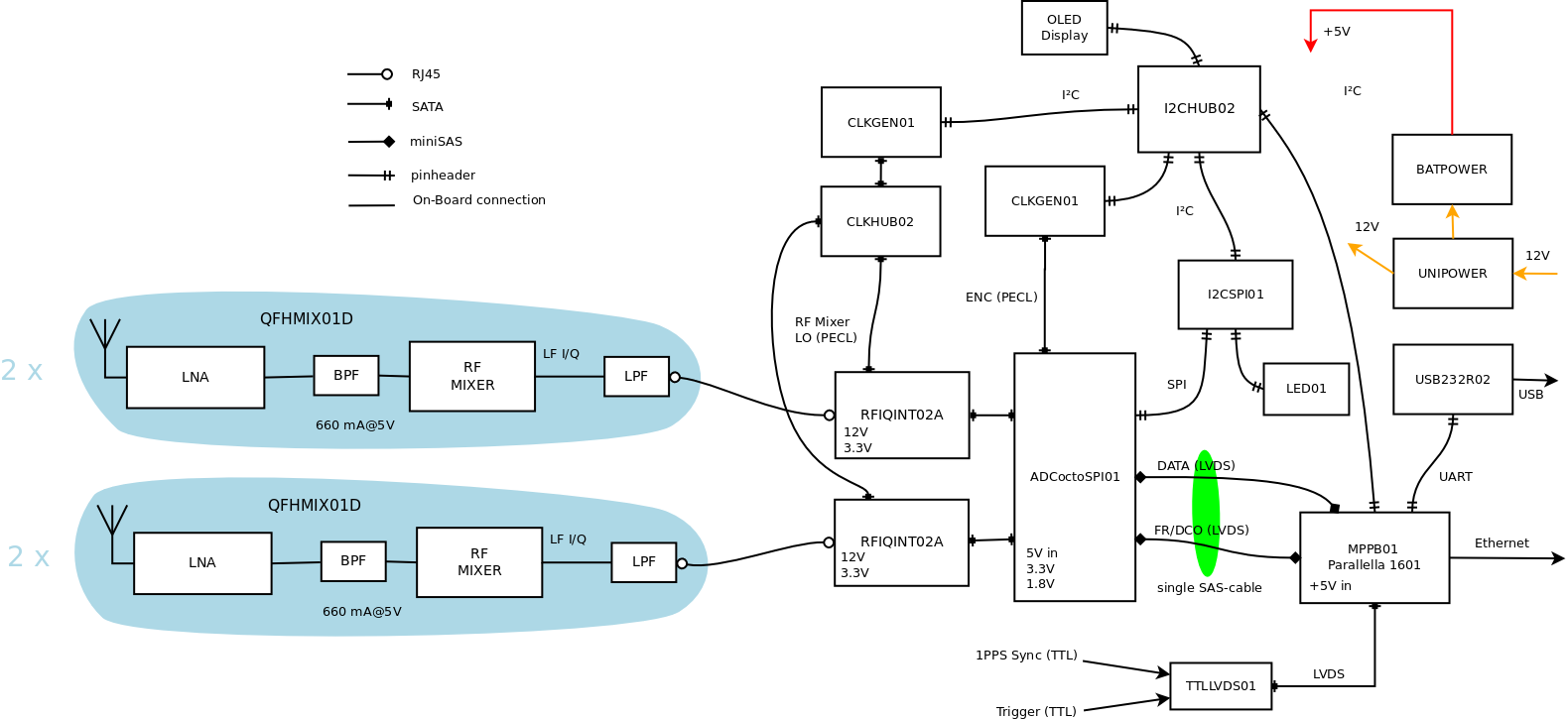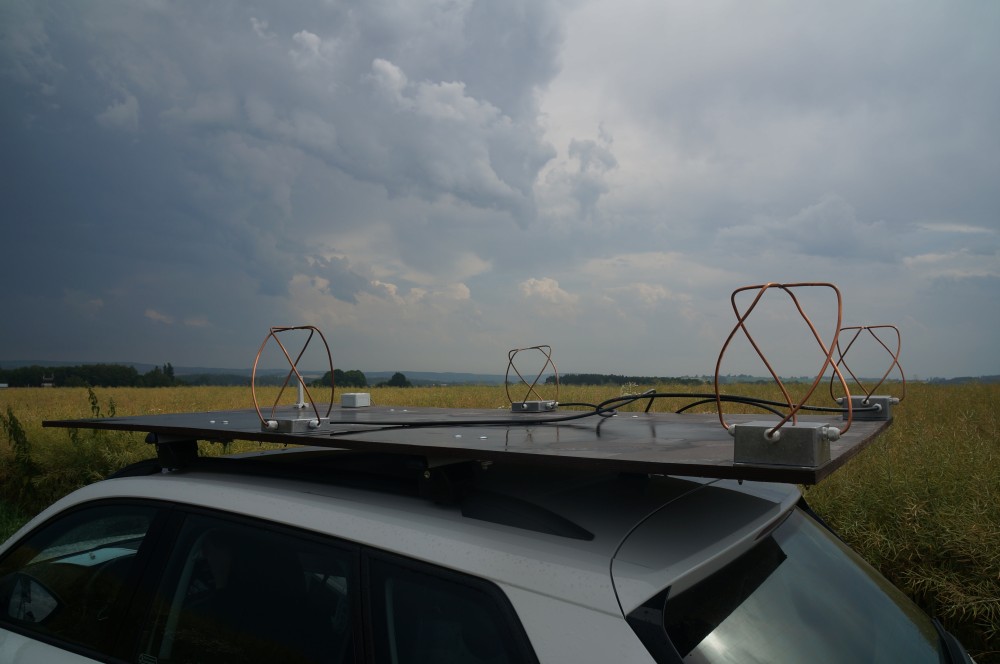RSMS01 – UHF Radio Storm Monitoring Station
RSMS01 is a UHF lightning observation station designed for ground or vehicle-mounted deployments. It complements the RSMS02 VLF receiver, which provides triggering and coarse detection. Together, both instruments capture long, contiguous, and time-synchronized RF segments of lightning activity for detailed post-processing. The system was conceived for research applications requiring high temporal accuracy and wide dynamic range, allowing detailed analysis of lightning structure and propagation.

Functional Overview
The receiver operates in the UHF band around 400 MHz, providing a contiguous 10 MHz capture window. This band is particularly rich in signatures of the initial lightning breakdown and leader formation, offering complementary information to lower-frequency systems. Each RSMS01 station combines a four-element antenna array, active front-end modules, and a base unit with high-speed digitizers. Signals from the antennas are fed as differential I/Q pairs over shielded CAT6 cabling, ensuring low noise and excellent channel synchronization even during mobile operation.
During operation, the VLF station (RSMS02) detects strong electromagnetic impulses associated with lightning and sends a trigger to RSMS01. The UHF station then preserves a selected time segment of the continuous radio stream — typically about 1.45 seconds — including data both before and after the trigger. Embedded GNSS-derived time marks make it possible to align individual samples with absolute UTC, which enables cross-correlation with optical, electric-field, or radiation sensors.
Technical Parameters
| Parameter | Typical value / range | Notes |
|---|---|---|
| Frequency band | 370–406 MHz | Tunable within local RFI constraints |
| Sampling rate | 10 MSPS | 12‑bit resolution per I/Q channel |
| THD (Total Harmonic Distortion) | ≈ −65 dBFS | Typical at 1 MHz input |
| Signal-to-Noise and Distortion Ratio (SINAD) | ≈ 63 dB | Optimal signal conditions |
| Input impedance | ≈ 5 kΩ | Differential, ~2 pF input capacitance |
| Input referred noise | ≈ 5.5 nV/√Hz | At VGA gain = 31 dB |
| VGA gain range | −5 dB to +31 dB | Step size 0.125/1 dB |
| Antenna type | 4× QFH (Quadrifilar Helix) | Circularly polarized, omnidirectional |
| Antenna connection | CAT6 differential pairs | 100 Ω, low‑noise I/Q link |
| Number of channels | 4 QFH antennas | Each antenna use one I/Q channel |
| Capture bandwidth | 10 MHz I/Q complex | Contiguous spectrum segment |
| Recording length | up to 1.45 s per event | Configurable pre/post number of blocks |
| Timing source | PPS | From external GNSS receiver |
| Timestamp precision | 100 ns | GNSS PPS timestamps |
| Trigger input | TTL from RSMS02 | Adjustable level and pulse width |
| Power supply | 9–15 V DC | Car plug compatible |
| Pre-trigger capture | Supported | Configurable window length |
| On-board computer | Zynq XC7Z01 SoC + Epiphany E16G301 | ARM + parallel coprocessor |
| Operating system | Linux (Ubuntu) | Web and CLI control interface |
| RAM / Storage | 1 GB / microSD (typ. 16 GB) | Data and configuration files |
| Network interface | 1 Gbit Ethernet | Data offload and remote control |
| Preview latency | ~2 s | Depends on configuration |

RF Front-End and Antenna Array
Each antenna element is equipped with an active front-end that includes a chain of band‑pass filters and low‑noise amplifiers for improved dynamic range. The down‑conversion stage uses a high‑linearity mixer with low‑jitter local oscillator distribution, followed by an anti‑alias low‑pass filter (≈ 5 MHz) and differential line driver. All components are enclosed in aluminum housings to provide effective electromagnetic shielding.
The four QFH antennas are arranged on a rigid, non‑conductive deck, such as a vehicle platform or building roof mount. Their circular polarization and wide‑angle response make the system suitable for capturing impulsive radio emissions regardless of lightning orientation.


System Operation
Before measurement, the antennas and active front‑ends are assembled and connected to the base unit. After powering up, the operator configures the VLF trigger levels in RSMS02 and starts monitoring. Once the trigger system is validated, the UHF recorder begins capturing radio bursts. Real‑time visualization can be performed using fosphor, which provides a live spectrum or waterfall view for verifying signal quality and interference conditions.
Data Format
Each recorded event consists of:
- Four per‑element I/Q streams (12‑bit, 10 MS/s, 10 MHz complex bandwidth)
- PPS time marks and sample indices for UTC reconstruction
- Trigger metadata (VLF detection parameters)
The data can be processed offline for interferometric or correlation analysis, allowing reconstruction of lightning event geometry and timing with high precision.